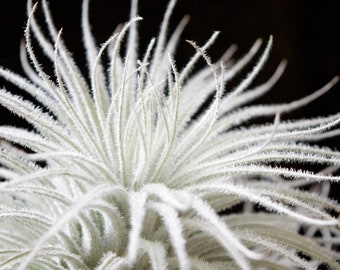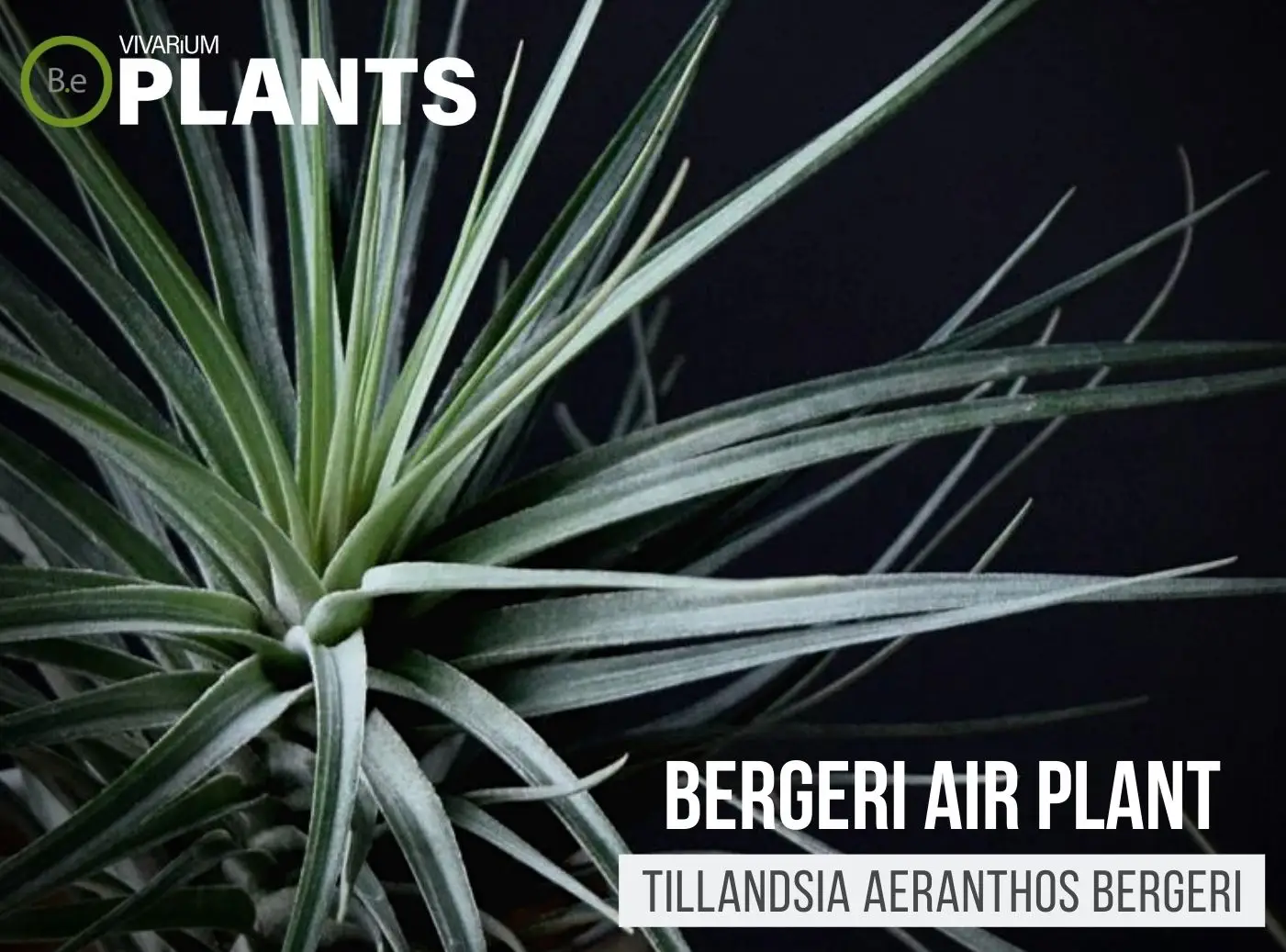Tillandsia tectorum is a terrarium air plant that is native to the volcanic region of Ecuador.
This plant is easy to care for, can create beautiful forms, and is perfect for any size enclosure.
Because of its hardiness, this plant does well in both hot and cold climates, and can easily adapt to varying levels of light, temperature, and humidity.
Tillandsia tectorum is a very attractive and unique vivarium addition in any type of planting setup.
Table Of Contents:
ToggleWhat is Tillandsia tectorum?
Tillandsia tectorum is a bromeliad species native to the volcanic zone of Ecuador.
It is a unique air plant that can grow without soil, consuming water and nutrients from the air.
This species is an epiphyte and obtains most of its nutrition from the roots coated with a protective layer of wax and trichomes, where it absorbs moisture and nutrients from its environment.


Tillandsia tectorum Facts
The Ecuadorian air plant is a very hardy and resilient plant, which makes it an ideal addition to the vivarium.
This species is not only drought tolerant but is also tolerant of mild frost.
The leaves are vibrant and get more elusive as it gains exposure to sunlight.
The leaves of this species grow in a rosette formation, and the plant can reach a height of 3-4 inches tall.
Description
Tillandsia tectorum is an air plant, it can grow without the need for soil.
It is an epiphyte, meaning it obtains most of its nutrition from the air and absorbs water and nutrients through its roots.
The leaves of this species grow in a rosette formation and can have a length of up to 8 inches when mature.
The leaves are usually bright green in color, and can sometimes have red tips due to their exposure to sunlight.
The plant will produce a flower stalk when it reaches maturity, which will bear small, pale yellow flowers.
Habitat
The natural habitat of Tillandsia tectorum is in the volcanic region of Ecuador.
This species thrives in warm, humid climates and can grow in lava rocks or forest floors.
In a terrarium, this plant will be best suited when it is placed in an area with moderate humidity and light levels.
pH Preference
The ideal pH level for Tillandsia tectorum is between 5.5 and 6.5.
This plant can tolerate a range of pH levels, but for best success should be placed in a substrate that stays within the ideal range.
Vivarium Type
The Ecuadorian air plant is quite an easy-going species.
With that in mind, it will not be too complicated when it comes to choosing the type of enclosure it is grown in.
It is best to try and replicate the plant’s natural habitat as much as possible.
Doing so will make it easier to provide this air plant with its basic needs.
The proper setup and theme of the enclosure will make a big difference to the overall look and health of the air plant.
Be sure to choose setups that are moist and high in humidity.
Here are recommended vivariums it will do well in:
- Terrariums – Fully terrain-based enclosures with little to no aquatic features.
Vivarium Placement
Tillandsia tectorum is an air plant, so it must not be placed underwater or on a substrate too saturated.
This plant can be placed on the ground or in the background of the enclosure and maxes out at 3-4 inches tall.
It is best suited in areas with moderate light and humidity levels.
Substrate
The Ecuadorian air plant does not need a substrate as it collects its water and nutrients from the air.
It should be placed in an area where it will receive equal amounts of light, water, and humidity, as well as be protected from strong air currents.
Lighting
Tillandsia tectorum grows best when it is placed in an area with a moderate level of terrarium light.
This species is resilient and can tolerate a range of light levels, but will not do well when placed in direct sunlight for extended periods of time.
It is best to stick to LED lights that provide a cool color of light for maximum success.
Buy Ecuadorian Air Plant
When it comes to buying an Ecuadorian air plant, there are a few things to keep in mind.
Making sure the plant is healthy when purchased is essential for its success in a vivarium.
Vegetation that is already in poor conditions will have a very hard time adjusting to new environments.
Click the image below to find out more about the current price and other relative info about this plant.
Tillandsia tectorum Care and Propagation
Tillandsia tectorum is an easy-to-care-for air plant.
To propagate, simply place small pieces of the plant in an area with adequate light and water.
The pieces should eventually form new plants of their own.
This species prefers a dry environment and should be allowed to dry out completely between watering.
How to Grow
Tillandsia tectorum is an easy-to-grow air plant.
When planting this species in the terrarium, place it in an area high on a hardscape.
Make sure it is not on a substrate or submerged underwater.
Watering
Tillandsia tectorum should be watered twice a week with filtered or distilled water.
When it is watered, place the plant in a bowl of water for a few minutes and then shake off any excess water that remains on the leaves.
Allow the plant to completely dry out between waterings and keep it away from sitting in water for long periods of time.
Plants Similar to Roof Air Plant
Adding diversity to an enclosure is key to an aesthetically pleasing setup.
Try mixing up the look of your vivarium with different flora that can easily co-exist in the same types of environment.
Furthermore, if you find Ecuadorian air plants hard to acquire or would like to consider something similar to this plant…
Here are other terrarium plants you might find will do well with or in the place of Tillandsia tectorum:
Conclusion
Tillandsia tectorum is a great addition to any setup and is a very hardy and resilient air plant.
It will adapt to a range of light and temperature levels and can grow with minimal care and attention.
It is the perfect plant for a beginner or experienced vivarium keeper and will thrive and create a beautiful, green rosette formation in any size enclosure.
Frequently Asked Questions
Tillandsia tectorum should be watered once every 3 to 5 days, allowing enough time for the plant to completely dry out before watering again.
1. Provide appropriate temperature and humidity.
2. Water tectorum sparingly and allow the top inch or two of the soil to dry out between watering.
3. Feed with a balanced liquid fertilizer diluted to a quarter strength.
4. Repot tectorum into a larger container as it grows.
5. Prune back tectorum to keep it in a desired shape.
6. Remove any existing dead or wilted leaves.
7. Put tectorum in a spot with lots of indirect sunlight.
Air plants should be soaked in water for approximately 15 minutes each week.
No, air plants do not need to be attached to anything in order to grow. They get their nutrients and moisture from the air, making them very easy to care for.
Yes, you can soak an air plant in water. Watering an air plant should be done by soaking the plant in water for several minutes once a week, then shaking off the excess water and allowing the plant to dry upside down before placing it back in its holder.






